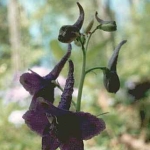| Common Name: |
Monkshood |
| Other Names: |
Aconite, wolfsbane |
| Botanical Name: |
Aconitum napellus |
| Genus: |
Aconitum |
| Family: |
Ranunculaceae |
| Cultivation: |
Deep, moisture-retentive soil in shade. Plants will also thrive in a sunny position if the soil is suffiently damp throughout the growing season; they do not flower well in dry conditions. Remove dead flower heads to encourage a second crop of flowers. Aconitums should be sited out of the reach of small children and animals, since even very small amounts can cause poisoning. Taller species need staking. |
| Propagation: |
By division when dormant; by seed sown in spring. |
| Harvest: |
Plants are lifted in autumn and young, thick roots are removed before replanting. Roots are processed professionally for use in decoctions, liniments and tinctures. |
| Warning: |
All parts of aconitums are highly toxic if eaten and may cause systemic poisoning if handled. Gloves should always be worn when handling, to avoid absorption of toxins through the skin.
For use by qualified practitioners only. Medicinal use is subject to legal restrictions in some countries. |
| Native Region: |
N and C Europe |
| Height: |
1.2-1.5cm (4-5ft) |
| Width: |
38cm (15in) |
| Varieties: |
Albidum
Description:Has gray white flowers.
Subsp vulgare Carneum
Description: Has delicate flesh-pink flowers and needs cool, rich, moist soil. |
| Hardiness: |
Z5-8 |
| Parts Used: |
Roots |
| Properties: |
A sedative, painkilling herb that acts on the heart and central nervous system, and also lowers fever. |
| Medicinal Uses: |
Internally for facial neuralgia and to relieve the pain of arthritis and gout. Externally for sciatica and arthritis, Used in homeopathy for shock (especially after surgery or childbirth), chickenpox, measles, mumps, croup, toothache and teething, and complaints caused, or made worse, by getting chilled. Excessive external use, or application to broken skin, may lead to systemic poisoning by absorption through the skin. |
| Bibliography: |
Encyclopedia of Herbs by Deni Brown Copyright © 1995, 2001 Dorling Kindersley Limited. pp. 100-101.
|

